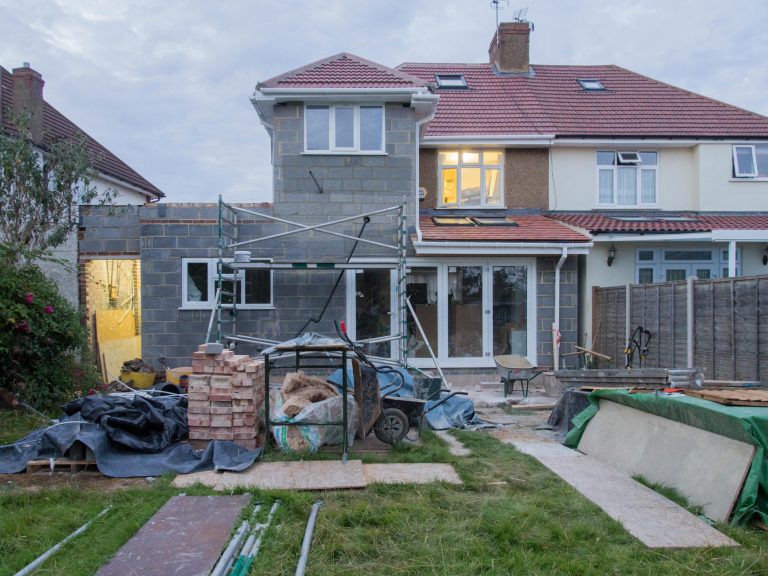Building a house is exciting but kinda terrifying too. Most of us design for the family we have right now, not the one we’ll become. After two custom builds (and plenty of mistakes), I’ve learned that the best family homes aren’t perfect on day one; they evolve as your family does.
Here’s what nobody tells you about creating a home that actually works for the long haul.
The “Forever Home” Trap – What We Get Wrong
We built our dream house when our kids were 5 and 7. Cute little art space next to the kitchen, perfect sight lines to the backyard, adorable jack-and-jill bathroom between their bedrooms. Fast forward six years—our son’s 6’2″, daughter’s friends are constantly sleeping over, and that art nook is just a dumping ground for backpacks and sports equipment.
That’s the forever home trap. You design for the family you have TODAY rather than the family you’ll become.
I see it all the time with clients. Young couples build with babies in mind, not teenagers. Empty nesters build for peace and quiet, then grandkids start showing up every weekend. Life changes, but houses aren’t great at changing with us.
Thinking Beyond Today’s Needs (Our Family’s Story)
When we finally got the chance to build again, we took a totally different approach. Instead of designing for our current life, we sat down and mapped out the next 20 years. Kids growing up and moving back home (yeah, it happens). Parents aging. Work is changing.
My wife thought I was nuts when I insisted on wider doorways throughout the house. “We’re not in wheelchairs!” But her mom moved in last year after her hip replacement, and suddenly those 36-inch doorways made all the difference.
Working with experienced builders who specialize in custom homes can make a significant difference when planning for your family’s future needs. Professional builders with multi-generational expertise can guide you through important considerations.
You might not think about – like ideal room placements, future accessibility requirements, and flexible design elements that adapt as your family evolves.
Flexible Spaces That Change Without Renovations
The key is building spaces that can transform without tearing down walls. Take our downstairs room; it started as a playroom, morphed into a homework zone, and now it’s where our teenagers hang out with friends. Same square footage, different furniture, different tech, different purpose.
Some practical approaches:
- Avoid built-ins that lock you into one use
- Use furniture to define spaces instead of walls
- Install electrical outlets EVERYWHERE (seriously, you’ll need them)
- Think about sound transmission between spaces
- Consider pocket doors instead of swing doors where possible
Let’s Talk About First Floor Bedrooms (Even If You Don’t Need One Yet)
“We’re young and healthy, we don’t need bedrooms downstairs.”
Yeah, that’s what everyone says. Then someone breaks their leg skiing. Or your mom needs to move in. Or you realize running up and down stairs all day is getting old.
Our first house had no downstairs bedroom option. Our new house has a home office that can convert to a bedroom with minimal fuss. The adjacent powder room was designed to expand into a full bath if needed. Not glamorous to think about, but future-you will be grateful.
Where Kids Actually Hang Out vs. Where We Think They Will
We had this grand vision of a finished basement rec room where the kids would play. Spent a fortune on it. Guess where they actually hang out? The kitchen island. Always the kitchen.
Seriously, wherever the food and the parents are, that’s where kids gravitate. The fancy basement sits empty while they’re sprawled across the kitchen doing homework, gaming on laptops, and raiding the fridge.
Better to invest in a kitchen that can handle the crowd—big island, plenty of seating, charging stations, and yes, good sight lines to wherever you actually cook. Trust me on this one.
Storage Solutions You’ll Thank Yourself For Later
Kids accumulate STUFF. Then they grow up and leave the stuff behind when they move out. Then they move back with MORE stuff.
Don’t skimp on storage. And I don’t mean those Pinterest-perfect cubbies that only work for perfectly folded tiny clothes. I mean real storage for real life:
Drop zones at every entrance, deep closets, attic storage with easy access, and garage systems that actually work. We added a small outbuilding that’s saved our sanity; sports equipment, holiday decorations, all that stuff has a home that’s not cluttering our living space.
The Truth About Open Floor Plans When Your Kids Get Louder
Open floor plans look amazing. They also mean you can hear your teenager’s video games while trying to work, and everyone can hear your arguments about curfew.
We went with a “modified open plan” the second time around. Kitchen and family room connect, but the dining room can be closed off. My home office has a door that actually blocks sound. Our master bedroom is far from the kids’ rooms.
Sound management matters more than most people realize when designing. Those cute toddlers get loud. Really loud.
Future-Proofing Your Home Without Breaking the Bank
You can’t predict everything, but some future-proofing is cheap if you do it during construction:
Experienced custom home builders bring invaluable insight to the future-proofing process. The best builders draw on multi-generational experience to anticipate how families evolve over time and can suggest practical modifications that add minimal cost during construction.
Extra conduit in walls for future technology. Blocking in bathroom walls for grab bars. Slightly wider hallways. Wiring for future needs. None of these add much cost during the build but are expensive retrofits.
We spent maybe an extra $8,000 on future-proofing elements, and it already paid off when we needed to add an electric car charger and accessibility features for my mother-in-law.
Designing for Teenagers Before You Have Them
Those adorable toddlers become smelly, privacy-obsessed teenagers with friends. Lots of friends. Plan accordingly.
Some practical considerations:
- Bathrooms that can handle multiple teens getting ready
- Bedroom locations that give parents some peace
- Areas where they can be loud without driving you crazy
- Storage for sports equipment, instruments, and hobby stuff
- Good internet throughout the house (non-negotiable)
Multi-Generational Living – Planning for Parents Moving In
About 20% of Americans now live in multi-generational homes. The odds that you’ll have parents or adult kids living with you at some point are pretty high.
We created a flex space that could become an in-law suite if needed. It’s currently our guest room and home gym, but could easily convert with minimal construction. The key features include a separate entrance, proximity to a bathroom, and some sound separation from the main living areas.
Why Most Playrooms End Up Abandoned (And What Works Instead)
Dedicated playrooms look great on floor plans but often become ghost towns. Kids want to be where the action is, not isolated in a room full of toys.
Instead, we integrated play spaces into our main living areas with clever storage and flexible furniture. The toys are where the family actually hangs out. As the kids grew, those same spaces transitioned easily to homework areas and now teen hangout spots.
Outdoor Spaces That Grow Up As Your Kids Do
That elaborate playset? It’ll be unused junk in about 5 years. Instead, think about outdoor spaces that evolve:
- Patios that work for trike riding and later for teen gatherings
- Yard space that can handle football with little kids and later fire pits for teenagers
- Storage for the ever-changing outdoor equipment needs
Our best investment was a simple concrete pad that started as a chalk-drawing spot, became a basketball court, and now hosts everything from ping pong to outdoor movie nights.
Technology Changes Everything – Planning for What’s Coming
The tech needs of a family home have exploded, and they’ll only increase. Our first house had sad wifi dead zones and not nearly enough outlets.
The new house has conduit to run future wiring, outlet placements that anticipated needs we didn’t even have yet, and a small dedicated closet for tech equipment. Not fancy, but incredibly practical as our needs have evolved.
Mistakes We Made Building Our “Perfect” Family Home
Even with better planning the second time around, we still got things wrong:
We underestimated storage needs (again). The mudroom isn’t big enough. The pantry seemed enormous until we actually filled it. And despite better planning, we still have dead space we don’t use effectively.
The main lesson? Be honest about how you actually live versus how you think you should live. Design for your real family, not your ideal family.
Finding the Balance: Resale Value vs. What Your Family Loves
The real estate agent in me wants to remind you about resale value. The mom in me says build what works for YOUR family.
The compromise? Make the weird, specific things you want removable or changeable. The rock climbing wall in my son’s room is mounted so it can be taken down and the wall repaired easily. The craft room has systems that can be removed to convert it back to a regular bedroom.
Build for your family first, but don’t ignore the reality that someday, someone else will live there.
Bottom line… the perfect family home isn’t perfect on day one. It’s the home that can adapt and change as your family evolves, without requiring a general contractor every few years. Plan for growth, expect change, and build flexibility into every square foot.


